Related articles
-
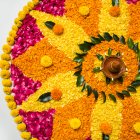 10 Exquisite Pongal Rangoli Designs to Celebrate the Harvest Festival With and Why You Should Practice This Ancient Art (2020)
10 Exquisite Pongal Rangoli Designs to Celebrate the Harvest Festival With and Why You Should Practice This Ancient Art (2020)
-
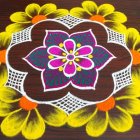 Need Some Help with Your Rangoli? Choose from These Amazing Makar Sankranti Rangoli Designs That Come with Useful Tips to Make Even Complicated Designs Seem Easy
Need Some Help with Your Rangoli? Choose from These Amazing Makar Sankranti Rangoli Designs That Come with Useful Tips to Make Even Complicated Designs Seem Easy
-
 Top Reasons Why Handmade Gifts are the Best Along with a List of 10 Homemade Friendship Day Gift Ideas for 2019
Top Reasons Why Handmade Gifts are the Best Along with a List of 10 Homemade Friendship Day Gift Ideas for 2019
Tips on Onam Celebrations
Rituals and Celebrations
One of the most popular art forms in the traditional arena of India’s cultural heritage, Rangoli is a decorative motif usually applied on walls or floors using varied forms of flowers and colours and is significant in celebrating festive and auspicious occasions throughout the country. Used differently in different parts of the nation, Rangoli in Kerela is known as Pookalam that marks the festival of Onam and denotes a colourful arrangement of flowers on the floor only. Placing a Pookalam is an essential ritual through the 10-day festival, where varied flowers and colors are used each day in honour of Onam celebrations, with beautiful designs made using a particular variety of flower for each of the 10 days and colors made naturally of cow dung.
Traditional Athapookalam: Symbolic Relevance
Pookalam being an integral part of the Onam Celebrations, derives its significance from the legend of Kind Mahabali who once ruled and visited his land during the festivities. The gorgeous motifs of colours and flowers are created at the entrance of Malayalee Houses to honour his spirit and invite peace, happiness and prosperity always. It is also believed that the 10 rings or Pookalam steps represent the 10 deities of the Hindu Pantheon, with the first rung representing Lord Ganesha, second defining Shiva and Shakti, third to Lord Shiva, fourth to Lord Bhrama, fifth to Pancha Bootangal, sixth to Shanmughan, seventh to Guru, eighth for Ashta Digpalakar, ninth for Lord Indra and tenth defining Lord Vishnu.
How to Make Unique Onam Pookalam Designs
Before the festivities commence for Onam, the floor of the doorway of a house is cleaned, and cow dung which is significant and considered sacred is spread all over the cleaned area. Motifs are then made using hairline bamboo sticks or a pin-like item. The pookalam is made on the first day of Onam, called the Atham day, usually with a simple design with yellow flowers mostly.
The pookalam is designed in 10 rings and the cow dung area is used for a floral pattern. The flower designs created during the festival get intricate with each passing day. For instance, on the 2nd day of Onam, a second layer is added to the Onam rangoli design at the least. Most Onam Pookalam includes motifs of peacocks, other birds, flowers or mango. Besides yellow, other colours like creamy yellow or orange are used to form the pookalam. On the 3rd day, you'll find Onam pookalam designs being created with 4 to 5 types of flowers, thus making the pookalam bigger in size. The pookalam size keeps increasing through the festivities, by the inclusion of a ring or a step on the outside to the initial pookalam design each day. On the main day of Onam, a really large pookalam gets ready.
The flowers used in the Kolam (Rangoli) include Kakka Poovu, Thechipoovu, Thumba, Chemparathy, Hanuman Kireedom, Aripoo, Mukkutti and Chethi. The designs in the Pookalam can vary simple to elaborate in style, while Thumba flowers are considered the best for their small size and glittering visual appeal, as they shine under the sun’s rays. Pookalam not only forms a vital part of the welcome celebrations during Onam but also makes for the essence of the festival.
Onam Rangoli Designs
Vermilion Base Colourful Rangoli
The vermilion base colourful rangoli is set on an uneven base made of vermilion, chalked out of a single point and then surrounded with circles, one after the other. The design is created with an orange circular pattern as a starting point, followed through with other colours like red, dark orange, green, brown, white, yellow, etc. After creating the important rings one around the other, you can move onto creating the external designs, with flame patterns. Begin with one circle in the middle and then create an oval-shaped design around it, using a mix of 2-3 colours. The entire design needs patience and neatness in its entirety. Complete the design with a lit Diya at alternative space points around the rangoli.
Panoramic Patterns Rangoli
This beautiful pookalam design shines with its bright yellow-orange and brown tones. Begin by creating a scenic view of a mountainside with a palm tree and a water body encompassing the area. You can use colours of yellow, brown, orange to highlight the skyline and the sun’s rays, while for the mountains and the palm tree, you can use varied shades of green. Create a water body with a mix of white and blue flowers/colours, finishing the first circle with a circular outline of lavender/purple coloured flowers. Next, move on to create the external patterns, which are shaped triangular/rhombus in shades of orange, yellow, dark & light brown, with a mix of green. You can make the design neat by using rangoli cones and chalking out the pattern before you begin.
Colourful and Shaded Flower Rangoli
Given the auspiciousness of the festival, orange and yellow flowers are a must use in Onam Rangoli, and you can further enhance the beauty quotient by spreading the hues to include red, white, green with a blend of other colours either in contrast or to balance it all. This beautiful design overlaps colours in the form of a floral pattern, with orange and yellow flowers shaped like an overlap of square likes shapes, giving the design a 3D look. Elegantly bordered with other colours, you can create shapes with each line by using different shaping/rangoli tools.
Purple Base Bright Rangoli
This design is huge and is best chalked out for a detailed and clean outline. This will help you plan colours and patterns for each line neatly for a more substantive appeal. Begin from the mid-point as you draw the circular patterns and move outwards with each circle, where you then arrive at the checkered areas where you can add in different colours. The patterns you choose can be shaped to your liking, however, when you come to the checkered areas, be sure to add only circular shaped colours to give the design a proper outline.
Pookalam Design with the Patent Colour
A beautiful blend of yellow and orange flowers with a mix of green, white and brown for Onam Celebrations is the perfect choice for this Pookalam. With easily shaped patterns, begin by making a white rhombus and outlining it on each corner with brown. Put a yellow petal in the middle. Then extend the design outward by making green coloured triangles and outlining them with orange flowers. Go further by creating flame-like patterns in red, extending out of the triangles and outlining them with a touch of white and yellow. Fill the gaps with orange and fill the final outline with green. You can use a mix of colours and flowers throughout the design.
Kathakali Floral Rangoli
One of the most appealing features of the Onam festivities is the Kathakali Dance and Drama. This Kathakali Pookalam represents a visually appealing form of a Kathakali dancer’s face adorned in flowers and comes out rather large. Since the face of a Kathakali dancer is painted green, the starting base should be green and as such should be barren, you can use green colours/flowers as you’d like to make for it. A mix of red, yellow, orange and white flowers can be used to give the entire design the authentic Kathakali dress-up, and then further adorned with floor lit lamps.
Blending Floral Patterned Rangoli
This gorgeous pookalam begins with the use of bright colours and culminates in darker tones, making it seem like one colour’s blending into another colour. The sunflower pattern has a different layer of colour at each level, which is best achieved by first chalking out the shapes before you begin colouring it all. Begin with filling in white, moving to yellow, followed by orange, and then a darker shade of orange, followed by two layers of red-coloured flowers and finally completed with brown coloured petals. Whilst you can be creative with your choice of shades with each colour, each layer must be achieved in proper alignment to give it the blending effect.
3 Dimensional Pookalam
A finely crafted and beautifully made design, this three-dimensional floral pookalam design needs a steady and practiced expertise with a huge amount of patience to see it to completion! The colours used in the design come together in creating a lovely illusion of a three-dimensional effect with the use of the usual colours of yellow, white, orange with an unusual blend of pink, lavender, peachish pink, shades of green and brown colours. The design begins with a few circular shapes of white-yellow-orange and brown, followed by irregular patterns of green in varying tones, lavenders and blues, petals formed in a darker shade of purple, again outlined with pink and then further circular outlines of white, yellow, orange, brown in varying shades.
Geometric Rangoli Design
This geometric pattern with a circular design with floral styling on the inside exhibits different shapes and forms with a fair amount of detail. It begins with a red circle on which a white dove with the Indian flag colours is made, followed by white triangles and squares of yellow, orange and brown, blending perfectly into each other. Then there are another few triangular layers of alternating colours, followed by arched forms of purple, white and the usual mix of yellow-orange-brown shades, seen to completion with circular shapes of white, yellow and orange again.
5 Colored Pookalam
Whether you choose to make a circle, a square, a rhombus or any other pookalam form, you can make the entire design a mix of just 5 colored flowers, which makes it easier for you to work with. The design requires white, saffron, red, yellow and violet colored flowers, and it can be as simple or complex as you’d like to work with. However, if you’re new to the art, it is best to go simple, making it a fun endeavor. Begin by creating the first circle in orange, followed by a circular pattern in red. Follow it up with another circular outline in white, making it bigger in violet in another layer, moving further with red again, with a much bigger circle in white, followed by a mix of red and orange petals and the final circle in at least 2-3 layers of yellow flowers.
Bonus Tip: Onam Decoration Tips
Onam Pookalam is a significant feature of the festivities and irrespective of what one’s religion is, nearly anyone who gets involved in the celebrations, enjoys engaging in the making of Onam rangolis as well. Usually, the rangoli is created with flowers in simple or intricate designs, which can be drawn with wet chalk, to begin with, and then followed through with the use of colours or flowers as chosen beforehand. Here’s a quick tip on how to decorate your home with Onam special pookalams!
- Warm Welcome: The most important décor aspect of the festival is flowers, given the harvest significance, which then calls for the use of fresh flowers to celebrate the occasion. The Pookalam at the entrance of a house gives off a vibrant feel and warm welcome to its residents and guests alike, not to forget the King, in whose honour the festival is celebrated! The beauty of making a Pookalam is that you can have a ball experimenting with colours, forms and span of the design.
- External Periphery: To adorn your bare walls, you can use marigold garlands or rose vines with fresh leaves, wrapping them around pillars as well to decorate your home, in addition to the Onam Rangoli. You can also beautify the pictures of your Gods and Family Elders you revere.
- A Touch of Fresh Fragrance: Keep bowls of sweetly fragrant jasmine or a mix of rose petals with marigold in water outside, in the living room and bedrooms, in addition to a bunch of sunflowers in a vase on the dining table.
- Light It All Up! Add finishing touches with elaborate brass floor lamps, diyas or earthern lamps on the steps, around the pookalam with a mix of electrical/LED fairy lights hung loosely or around trees to make it, even more, brighter and festive.
Related articles
-
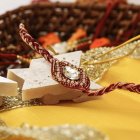 Gift Your Sibling Something Unique on Raksha Bandhan 2019: Choose from Our 12 Recommendations for Brothers and Sisters to Let Them Know How Much You Care!
Gift Your Sibling Something Unique on Raksha Bandhan 2019: Choose from Our 12 Recommendations for Brothers and Sisters to Let Them Know How Much You Care!
-
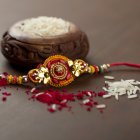 8 Beautiful Rakhis for Brother and 10 Creative Rakhi Gifts for Sister (updated 2019). Plus A Look at the Traditions Surrounding Rakhi
8 Beautiful Rakhis for Brother and 10 Creative Rakhi Gifts for Sister (updated 2019). Plus A Look at the Traditions Surrounding Rakhi
-
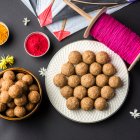 Celebrate Makar Sankranti the Traditional Way: What to Do and How to Do It Plus 10 Great Gifts to Give Family and Friends (2019)
Celebrate Makar Sankranti the Traditional Way: What to Do and How to Do It Plus 10 Great Gifts to Give Family and Friends (2019)
-
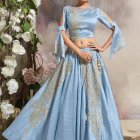 What If You Can Make an Exclusive Designer Dress by Re-Using Your Old Saree(2020)? Create Magic by Transforming Sarees into Lehenga Using Our Craft Ideas and Be Proud of Yourself!
What If You Can Make an Exclusive Designer Dress by Re-Using Your Old Saree(2020)? Create Magic by Transforming Sarees into Lehenga Using Our Craft Ideas and Be Proud of Yourself!
-
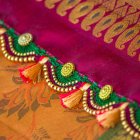 What is Saree Kuchu and How to Find the Perfect Saree Kuchu. 10 Must-Have Designs and Why You Should Use Them (2020)
What is Saree Kuchu and How to Find the Perfect Saree Kuchu. 10 Must-Have Designs and Why You Should Use Them (2020)
Choose Your Materials for Rangoli Art
First, you should decide what materials you will use for your Rangoli design before getting started and have them on hand.
Many people use pigment powders especially created and sold for making Rangoli art, but you could also use flower petals, sand, rice powder and/or paste stone or brick powder, or chalk. Grains and beads can also be gathered to use along borders and provide a 3-D effect. Diyas or candles are usually included in some part of the design. Since rangoli is found in homes of all income levels, people improvise and use what they have on hand.